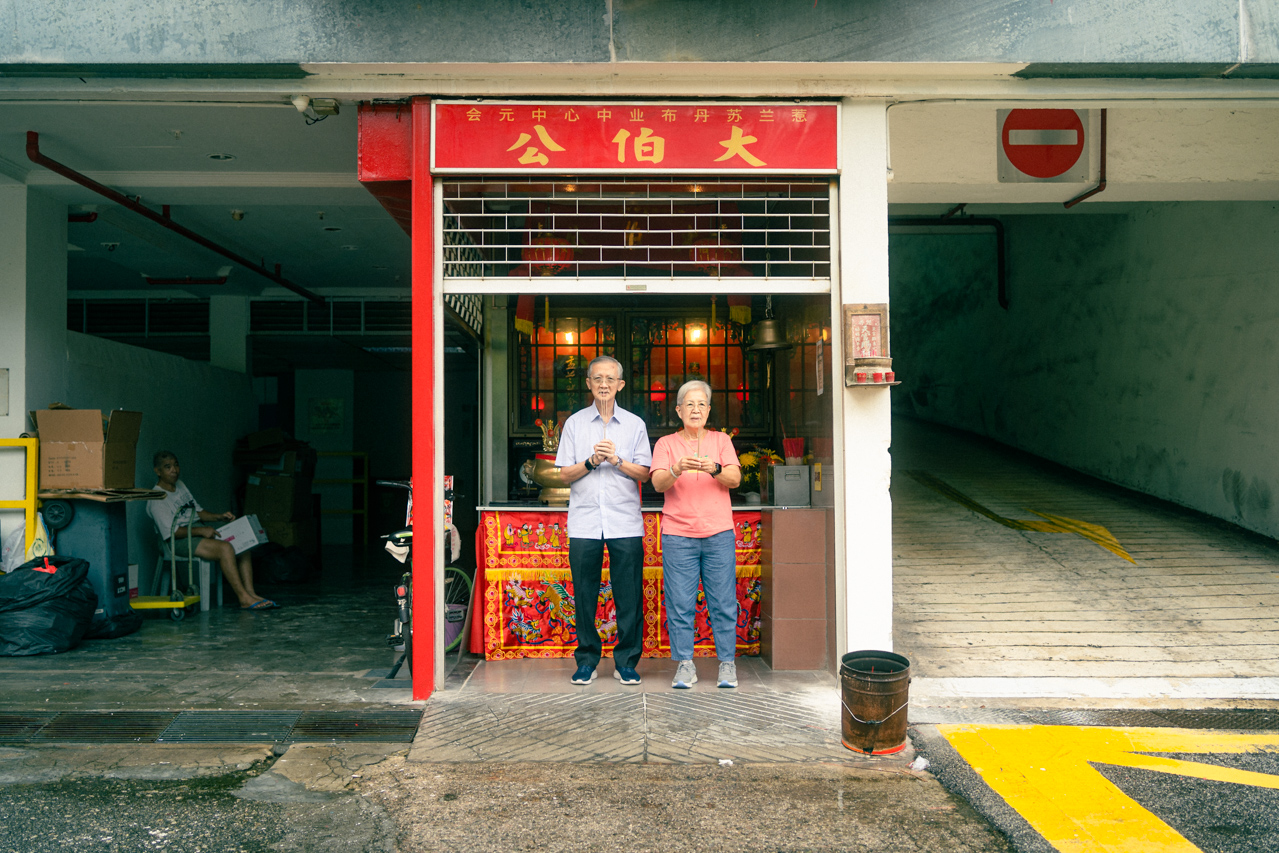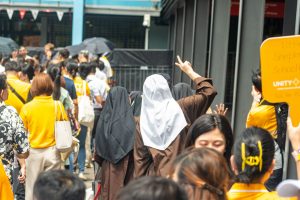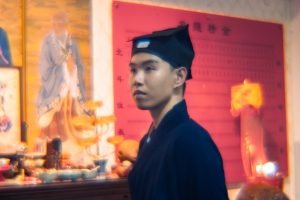All images by Stephanie Lee for Rice Media
In the wee hours before Jalan Sultan’s Textile Centre opens, Zhang Hui, a part-time karung guni man and deity attendant in his 70s, makes his way to an altar behind the strata mall.
Located between the entrance of the carpark and the garbage disposal area, the altar is adorned with Chinese Taoist deities. A cursory glance reveals two statuettes at the altar, both rotund and male—plump with power and mystical sway.
ADVERTISEMENT
“Since 1993, six days a week, sometimes seven if it’s a deity’s birthday, I’ve been in charge of opening up the display and locking up the altar after hours,” Zhang Hui says gruffly.
I remark on his dedication to such a rigorous schedule. “I get a small token for what I do,” he shares nonchalantly.
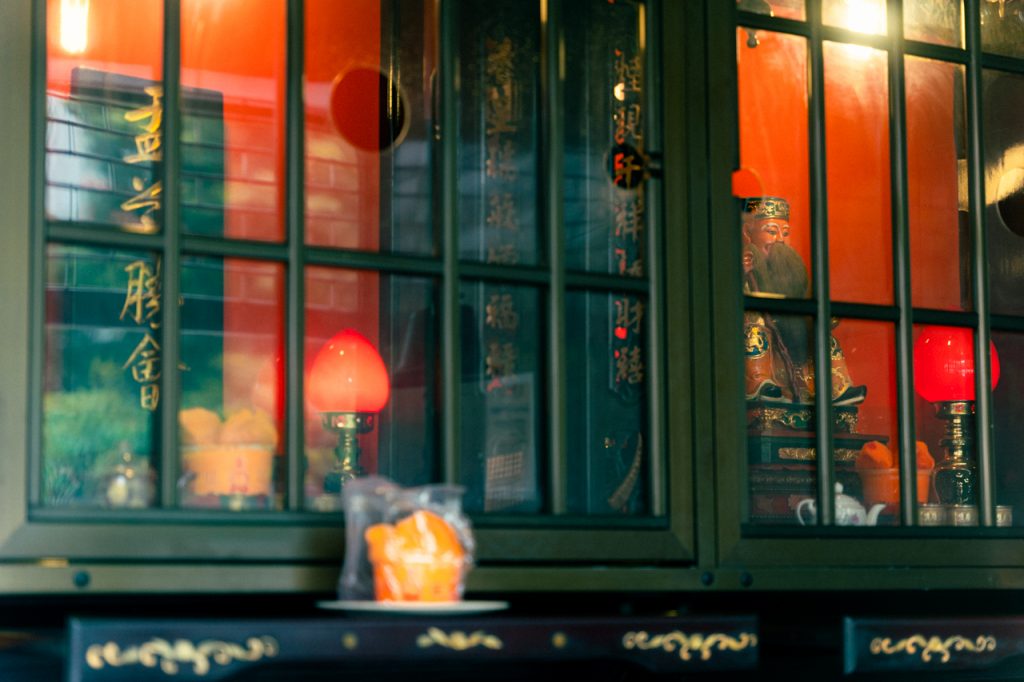
After serving the deities tea, Zhang Hui would rest easy until nightfall, when another set of duties elsewhere in the ageing mall demanded his attention.
The altar Zhang Hui takes care of is just one of the many altars peppered in carparks across the country. They often take up space at industrial sites, bus interchanges, or near residential areas.
The fact that all these places enjoy intense foot traffic and serve a practical purpose is, perhaps, a happy but curious incident.
In our constant pursuit of rejuvenation, where buildings are constantly torn down and refurbished, these altars and the practice of using them become unintentional collateral damage. We are a nation alienated from the spiritual nature of our lands, and it shows.
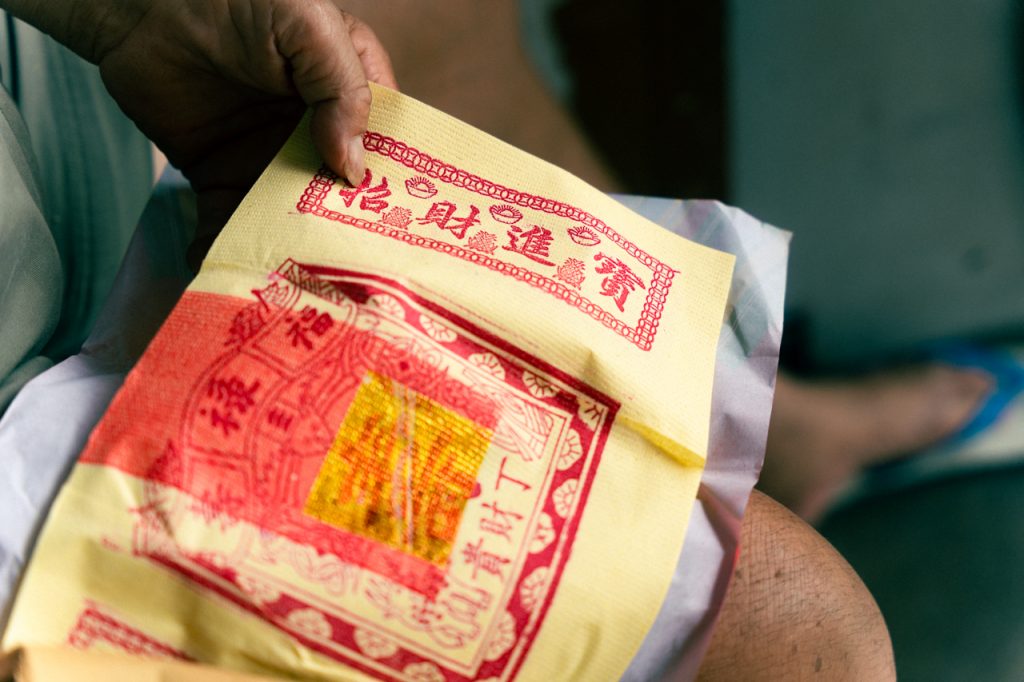
Mysterious Caretakers
The altar at the Textile Centre’s carpark wants to be hidden. If that’s its objective, it has succeeded.
ADVERTISEMENT
The altar’s only point of identification is its colour—a distinct and striking shade of red that burns bright against the dreary concrete of the rundown carpark.
The idols are propped above eye level, protected behind steel gates ravaged by time and rust. Their once ornate robes are faded and frayed at the edges.
On the table, two censers holding incense sticks are in various stages of being lit or extinguished, filling the air with an earthy scent.
Hunched over, focused intently on folding an array of cardboard boxes and cartons, Zhang Hui rattles off his routine in Hokkien. Our quasi-translator, Ming Wei, a store consultant in his late fifties who works at the Textile Centre, attempts to communicate everything in a jiffy.
Time is of the essence—they need to get back to work.
When I ask Zhang Hui to help me identify the different gods on the altar, I’m met with silence. It’s hard to tell whether it’s reticence on Zhang Hui’s part—or that he might not know for sure himself.
“This is just a job to him,” our translator, Ming Wei, elaborates. Grinning sheepishly, he adds: “Out of sight, peace of mind.”
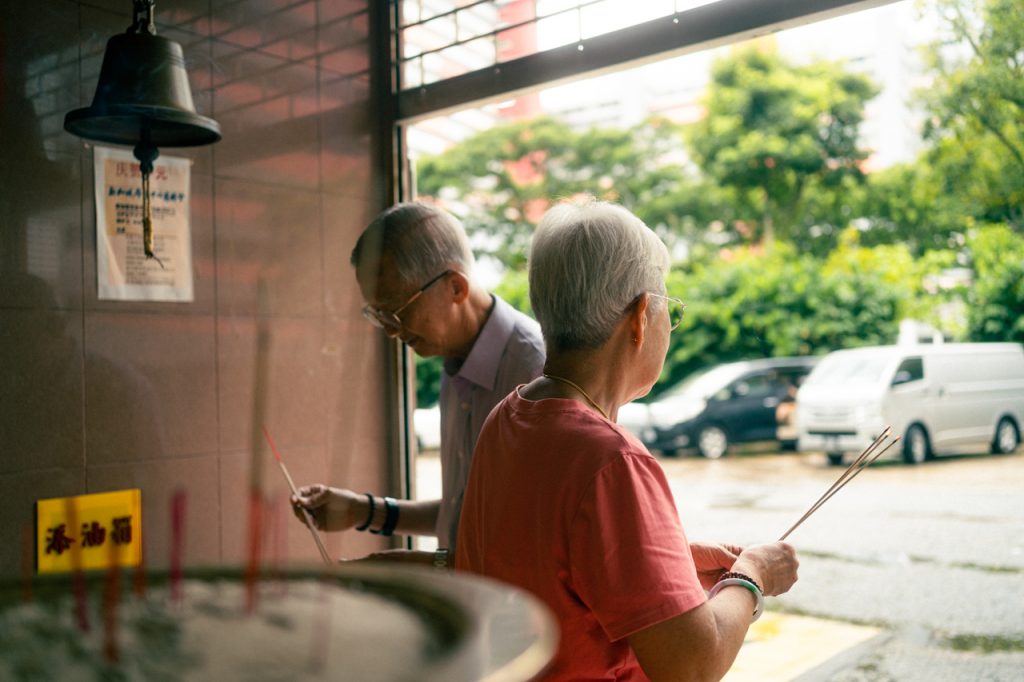
Murky Origins
Perhaps, more can be gleaned from those who frequent the altar through the years.
In a starkly-lit room in the mall filled with rows of equally bright and coloured fabrics, I met Ku Gey Nga, one-half of the 80-year-old couple that runs Eng Huat Hock Kee Trading Company.
“Before I even open up shop, I will pray to the deities at the carpark, and I’ll do it again before I close up—every single working day,” says Gey Nga.
Gey Nga explains how the business was passed down to her by her grandmother, just as her Taoist faith was instilled in her since young by the family matriarch.
“Every time before I leave the house, I will always pray at the altar in my home,” Gey Nga adds proudly.
“My grandson does it too. Like clockwork,” she insists. “It’s already a matter of habit.”
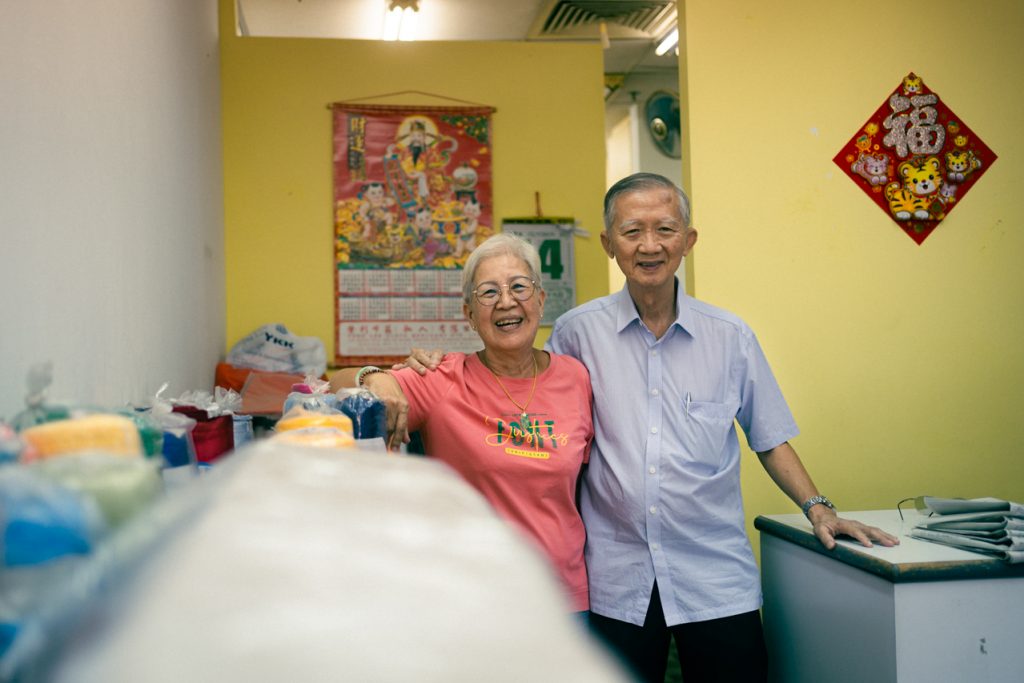
Despite the decades spent engaged in this routine, the basement altar’s origins remain murky to her. “I think it was a bunch of Chinese merchants in this building that chipped in to build it, but there’s no way of knowing for sure,” she shrugs. “One day, I just started praying, and I haven’t stopped since.”
ADVERTISEMENT
She finds the location of the carpark altar convenient—appropriate even. “Here, it doesn’t bother anyone; we don’t want to bother anyone as well.”
Ku Nga’s husband and business partner, Low Kok Tiong, shares her philosophy on maintaining peace and neutrality. “It doesn’t matter what faith you follow, as long as you treat every situation and person respectfully. Why would you want to start any conflict?”
He too conducts daily prayers at the carpark. This practice reminds Kok Tiong that “there is more to life than the fixation of running a business and earning a living, especially in growing Singapore.”
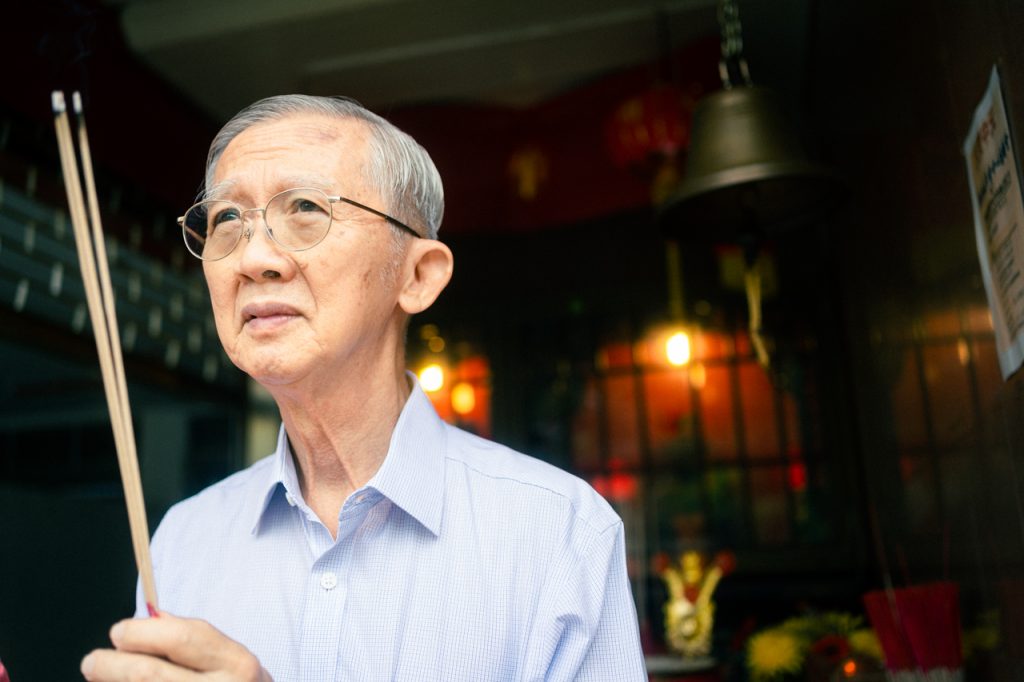
Superstitious Beginnings
While Kok Tiong offers a pleasantly insightful account, I couldn’t take it as uncontested truth. Further investigation shows that the origins of such carpark altars could very well be rooted in practicality.
“Carparks are quieter and more 暗 (dim), and there is the fear that malicious spirits will manifest,” Jack Meng-Tat Chia, Assistant Professor of History and Religious Studies at the National University of Singapore, contextualises. “So they are located there to prevent this—and traffic accidents.”
“Chinese religious worship can have a very pragmatic-otherworldly function,” Professor Chia affirms.
For commercial or industrial buildings, “carpark altars are so common that even when the supervisors are not religious followers, most would still allow their employees to erect them so long as they do not impact the perceived image of the company,” says Professor Chia.
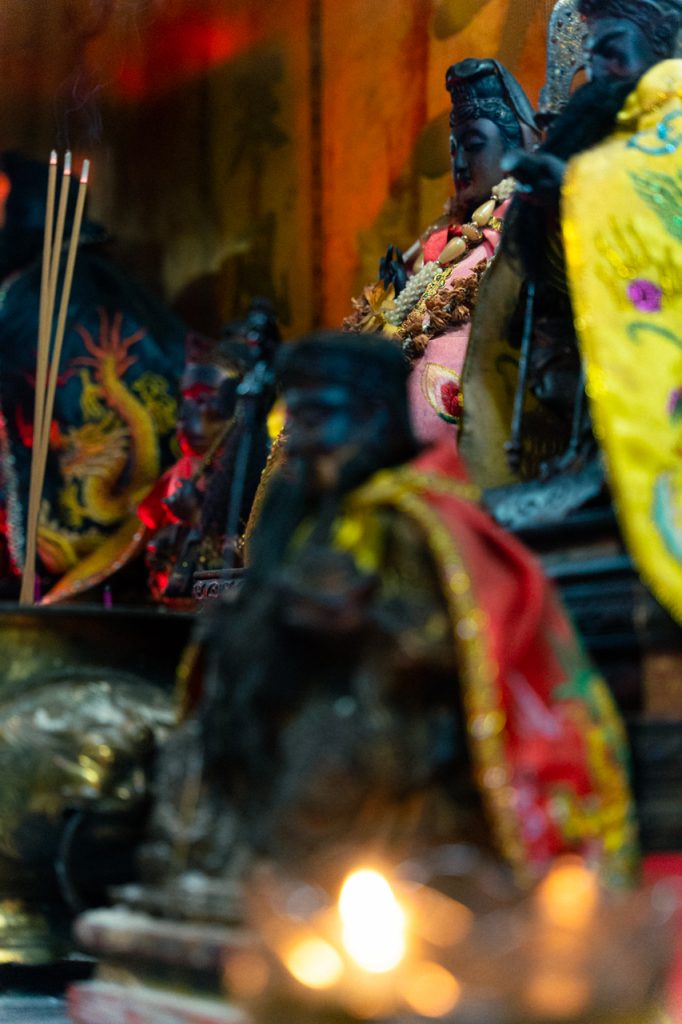
This religious tolerance on behalf of the managers can also be attributed to superstition and cautiousness, a trademark of Singaporeans.
Professor Chia provides two Chinese proverbs in explanation, “There is a belief that ‘拜得神多, 神保佑’, which means the more you worship, the more blessings you will get, so you just want to continue to get these blessings. Some also believe, ‘宁可信其有,不可信其无’ , which means they would rather accept something as true rather than completely reject it.”
Professor Chia raises an example of how someone of a different faith might approach a carpark altar.
“Business owners can be Christians who don’t quite believe in these shrines, but some may believe in the presence of spirits and choose to add their version of such shrines.”
“Again, there is a worry there might be bad luck, or it might affect their business if they shift the altars.”
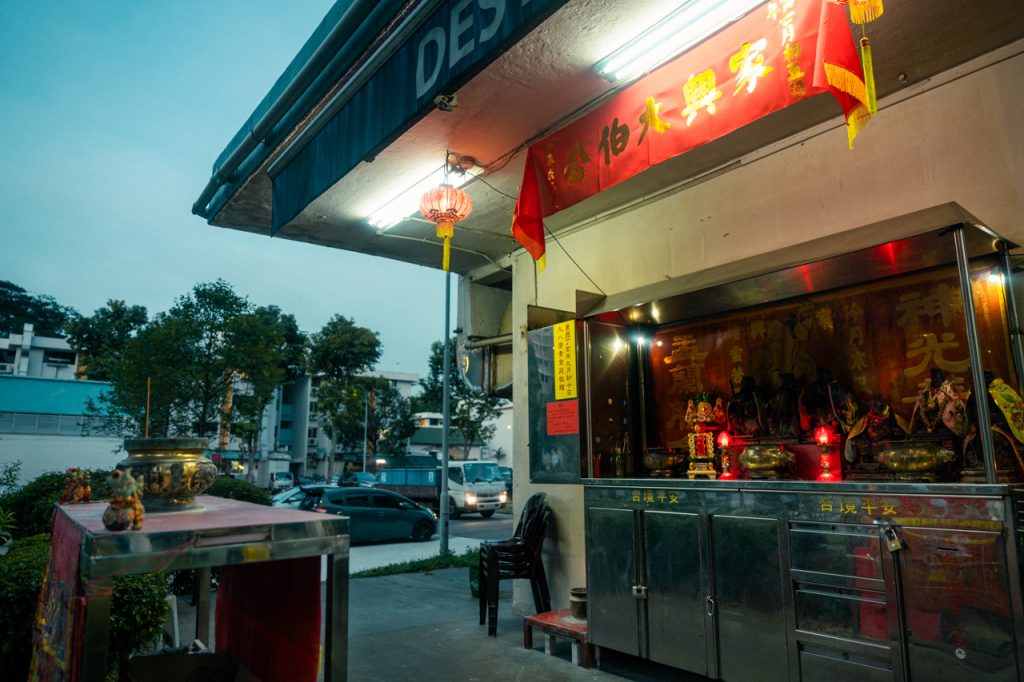
An Unexpected Coexistence
While the supposed beginnings of these altars stemmed from more practical reasons, they are now ingrained in everyday Singaporean life.
“There’s not much to it. It’s just for the safety of people in the area—the car park, the coffee shop, the residents—the list goes on,” Yap Peng Ann explains. The 64-year-old is a drink stall operator at 446 Ang Mo Kio coffee shop and prays at an altar nearby before he starts work.
The deity display is mere metres away from his stall, positioned at the rear corner of the eatery and away from the customer’s prying eyes. On its left is an open carpark. Further down are HDB blocks.
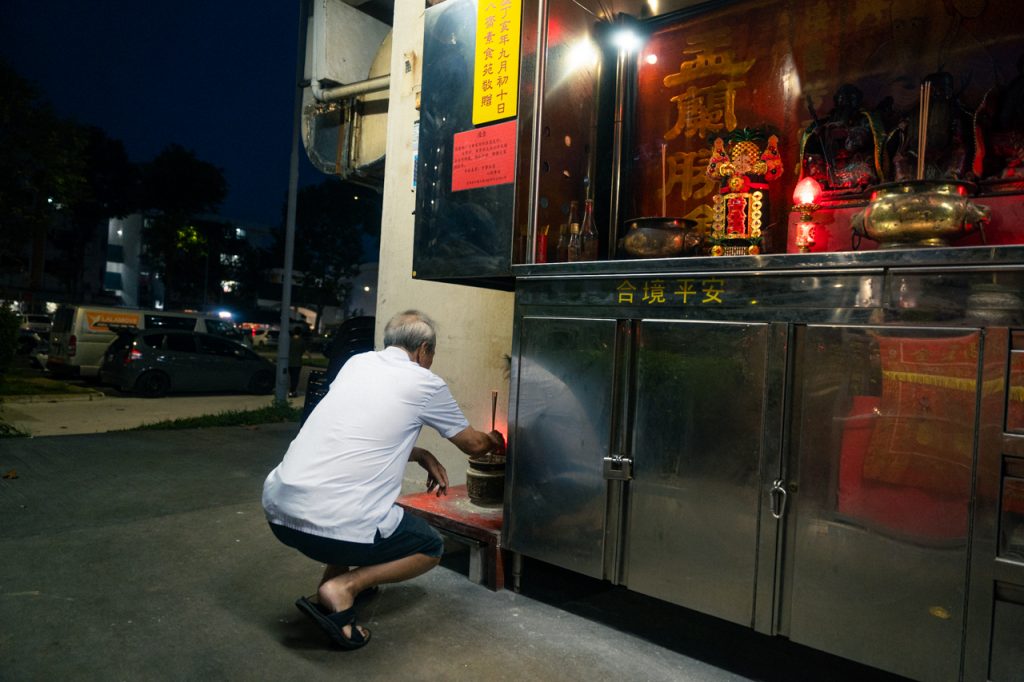
Unlike the one at Textile Centre, here, the altar is a lofty and formidable aluminium structure, unafraid to take up space. It holds approximately half a dozen gods sitting atop numerous drawers locked shut, its contents unknown.
Due to the exhaust steam produced by the stalls, the deities are covered in a light sheen of soot and gleam slightly with grease. Still, they maintain a deft appearance, draped in black, green, red, and yellow capes.
The male deities sport long black beards; a few wear scaly metallic armour. There’s an ombre effect on them, where the green scales lighten and darken at certain spots.
A towering, balding figure with a lengthy white beard grasping a staff sits front and centre.
The back of the display is wallpapered entirely with a sprawling red and gold poster. It is embellished with traditional Chinese words expressing the Christian equivalent of a ‘hallelujah’.
“There’s nothing really remarkable about their presence, and it seems like they have always been here for ages,” Peng Ann yells out to me over the hubbub of a dinner crowd.
“I don’t have much of a relationship with the altar. It’s just like that; what else do you want to know?” he shouts hurriedly. “People working around here pray to it, then we will do other things.”
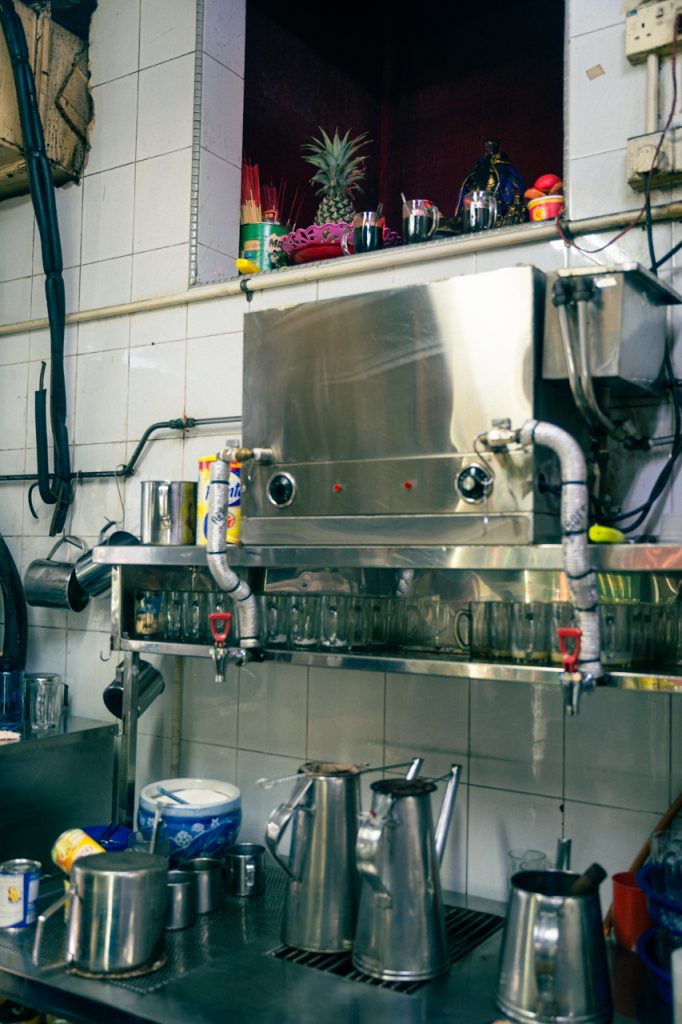
Pointing to a niche near the ceiling of his stall, a makeshift deity makes itself visible only to the keen eye. Getting as close as I could to the stall, it was difficult to perceive any distinct detail from the dark silhouette.
When I wondered aloud how and why he chose to place a deity so high up, he shot me a toothy grin. “Now, that one is just for my stall. The big one outside, that one I don’t know who put it up or why. But I know he’s long dead.”
Worship FOMO
There is one last location to scout. Perhaps Boon Lay Place Market and Food Village can shed some clarity as to why two altars can be placed in such close proximity to each other. After all, there are not one but two deity displays, each on opposite ends of the market.
They are relatively small compared to the altar at the Textile Centre—almost diminutive in comparison to the altar at 446 Ang Mo Kio coffee shop.
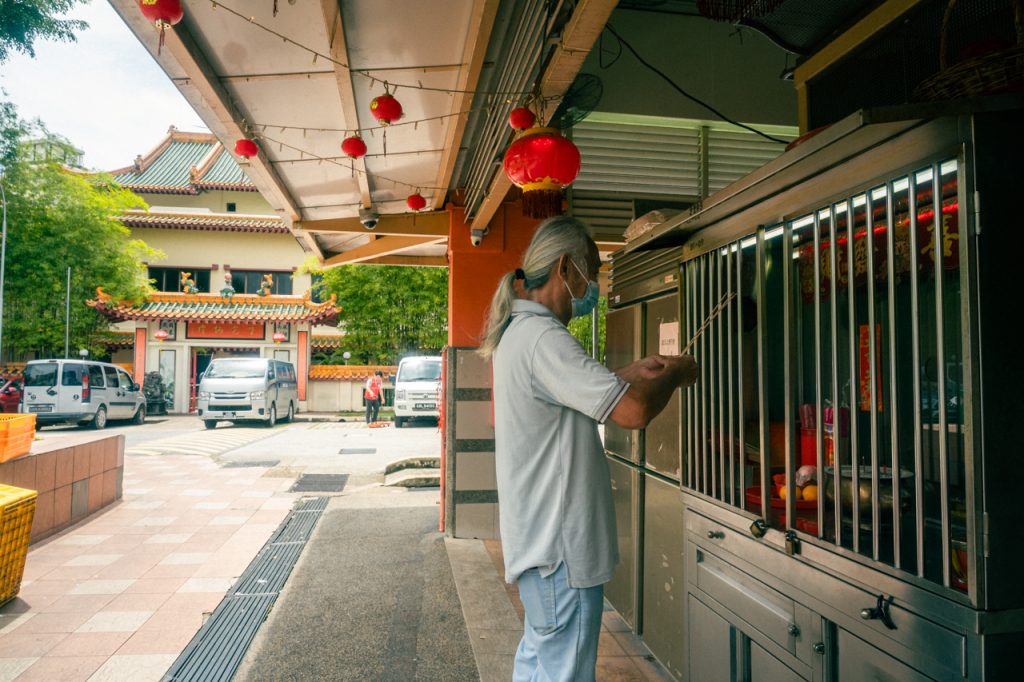
At Boon Lay Place, the altars are nearly entirely decked out in metallic silver, save for the deities and the red lights illuminating them. And instead of full-sized red and yellow Chinese lanterns, one of the altars has more miniature lanterns strung up above it, held flimsily together by red fairy lights. The Taoist god of prosperity, Tua Pek Kong, sits centre stage.
Collective prayer sessions would be conducted on the first and fifteenth day of every lunar month. These are attended by devotees and believers, although some who don’t practice the Taoist faith join in too.
“Since everyone else here does it, I’ll just do it. There’s no harm in doing it,” one stall owner of the Buddhist faith explains.
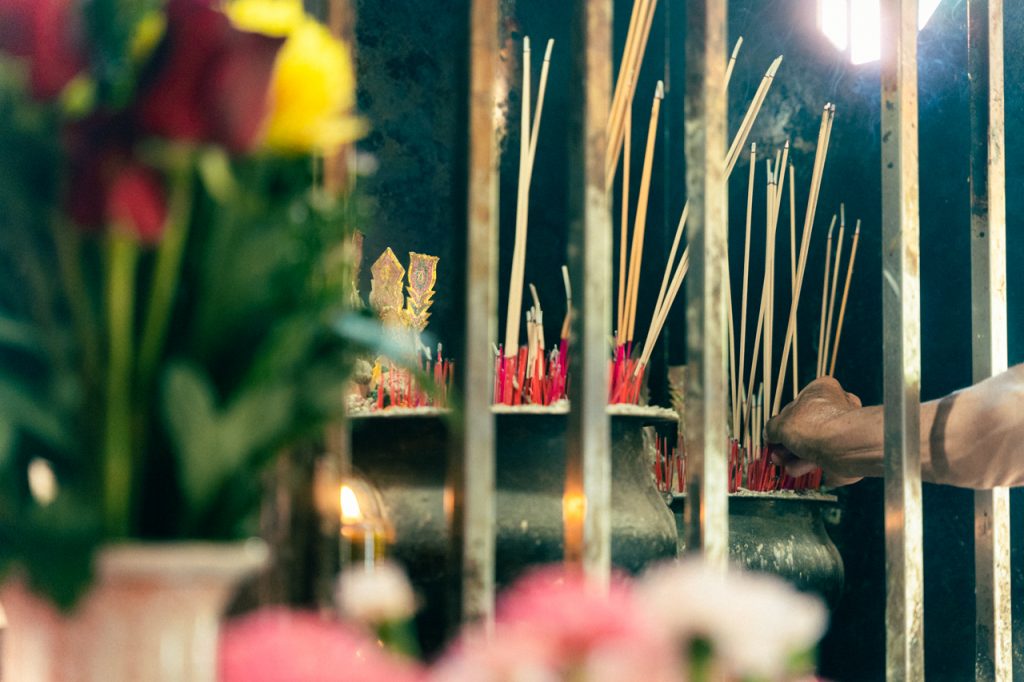
Professor Chia says that this practice can be recognised as inherently Singaporean. “It’s common in Singapore to see this interesting hybrid of Buddha, Taoist gods, and Hindu deities. Even a type of local Malay God known as the Datuk Keramat will be [on the altar] .”
“Sometimes, Muslims and Hindus will pray to these shrines too, even though it is not considered canonical or orthodox.”
However, multiculturalism appears not to be the only Singaporean element at play.
The Boon Lay Tua Pek Kong Temple, featuring the eponymous deity, is only metres away from the two altars near the market. Is this a case of double the god, double the blessings?
The temple attendant of the Boon Lay Tua Pek Kong Temple explains the deity in the temple “blesses the overall vicinity—the car park, the vendors, the market, everything.”
So, why put up an altar for the same god a stone’s throw away, I ask?
“What belongs to the temple is the temple’s. This is ours,” the stall owners chimed in.
“I think it can represent the kiasu-ness of Singaporeans and Singaporean culture,” Tan Hong Jun, a 23-year-old student walking past the altar, suggests. “There’s a desire to feel secure and cover all the bases.”
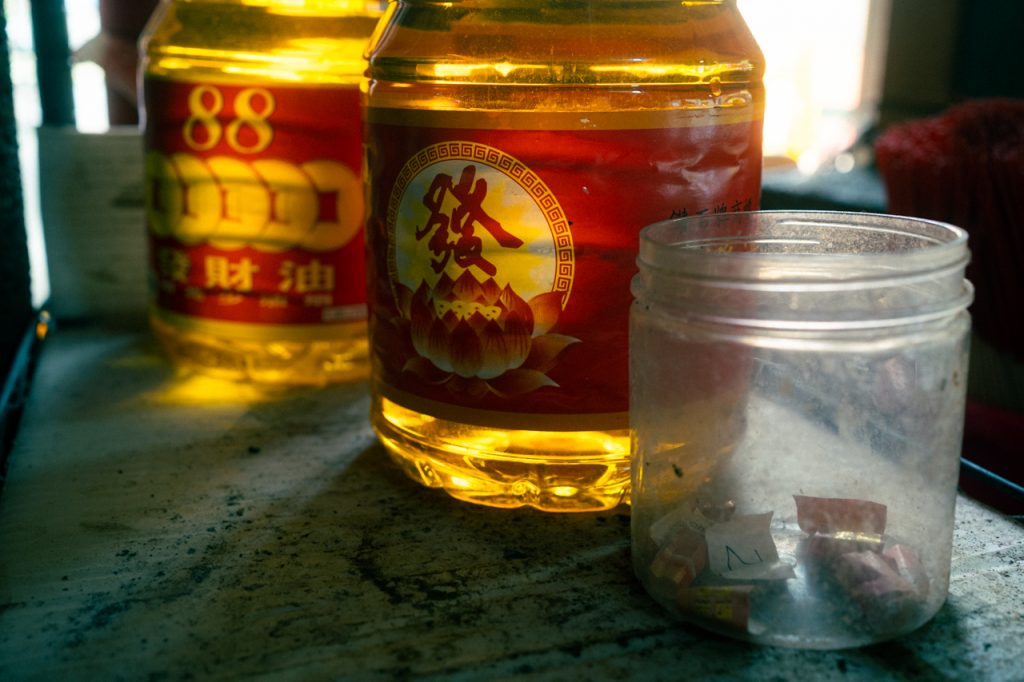
Don’t Stop Believin’
Hong Jun tells me that although he was raised Taoist, he has not decided if his family’s faith suits him. Still, he observes the Hungry Ghost Festival with little to no emotional connection.
Hong Jun can be taken as an example of the young and undecided who remain unsure about religion and tradition. As Professor Chia posits, “there are more anglo-phones who no longer see themselves aligned with traditional Chinese culture or worship or view them as very relevant anymore.”
“Of course, I think these shrines are likely to be around,” he offers when I ask about the future of such neighbourhood shrines. “But it depends on whether the younger generation will continue to believe in these gods or if they want to maintain the shrine.”

Gey Nga expresses a similar uncertainty. “I don’t know about young people, whether they’ll learn about this practice or even if they want to. I just know I will continue praying to the deities for as long as I can.”
Carpark altars are adaptable to a variety of needs. Whether you seek prosperity, peace of mind, or just a desire to keep with tradition, there seems to be something for everybody.
“Everybody needs something to believe in,” Gey Nga intones.
“Sometimes it just happens to be religion—any type of religion. Society can be in disarray, and as humans, we need something to hold on to, wherever we find it.”

